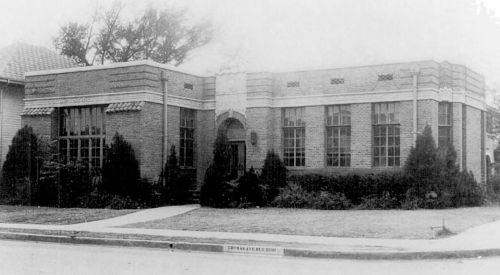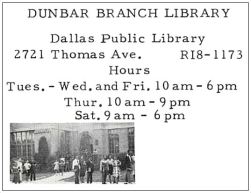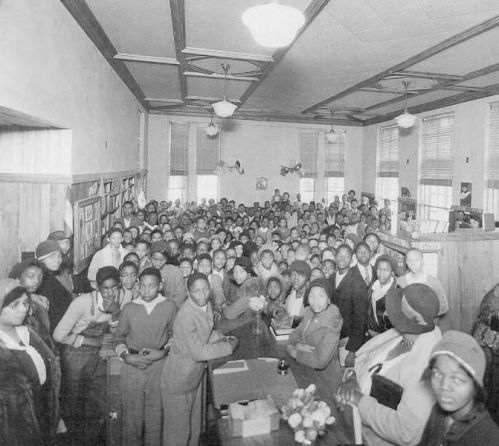The Dunbar Branch: Dallas’ First Library for the African-American Community, 1931-1959
by Paula Bosse
 The Paul Laurence Dunbar Branch of the Dallas Public Library
The Paul Laurence Dunbar Branch of the Dallas Public Library
by Paula Bosse
The Paul Laurence Dunbar Branch of the Dallas Public Library was the first library in Dallas to welcome and serve the African-American community. It opened in June, 1931 at the northwest corner of Thomas and Worthington in what was then the predominantly black neighborhood of “North Dallas” (the area is now known as “Uptown”), a thriving business and residential neighborhood which was home to everyone from the city’s black professionals who lived in large, lovely gingerbread-style houses, to middle- and lower-class black families who lived in more modest homes.
This was a time when almost every aspect of life was racially segregated — the grand downtown Carnegie Library was expressly off-limits to non-whites, and few of the black schools had any sort of functioning library. It was a long, hard bureaucratic battle of petitioning the city, the state, the Carnegie corporation … anyone … for a library which the city’s woefully underserved black citizens could call their own. It took years until the powers-that-be gave the go-ahead to finally build one. The building was designed by Dallas architects Ralph Bryan and Walter Sharp.
The charming one-story, brick-and-reinforced-concrete building was very, very popular and was a source of pride in the community. And it was beautiful!
 The reference and reading room
The reference and reading room
 Children in costumes to celebrate National Book Week, Nov. 1949
Children in costumes to celebrate National Book Week, Nov. 1949
Even though the photo featured in the ad below is very grainy, it’s still kind of cool (from 1958, one year before the branch closed).
 1958 Lincoln High School yearbook
1958 Lincoln High School yearbook
In the late 1940s, construction began on Central Expressway. Unfortunately, this much-needed highway cut right through the heart of the North Dallas/State-Thomas/Freedman’s Town area. The destruction of many of the area’s buildings and displacement of many of its residents was a devastating blow to the African-American community who lived, worked, and shopped there. That and other economic forces led to the eventual dispersal of the area’s black population to other parts of the city. By the 1950s, the library had lost many of its core patrons, and in 1959 the Dunbar Branch closed. At some point that beautiful building, located just a few blocks south of McKinney Avenue, was demolished. The historic State-Thomas area has now been almost completely obliterated as “Uptown” has taken over. And another part of the city’s history has been lost.
***
Sources & Notes
All photos are from the book Dallas Public Library, Celebrating a Century of Service 1901-2001 by Michael V. Hazel (Denton: University of North Texas Press/Friends of the Dallas Public Library, 2001); photos are presumably from The Texas/Dallas History & Archives Division of the Dallas Public Library.
Hazel’s chapter on the Dunbar Branch is well worth reading. Not only is it interesting (and kind of shocking) to learn the lengths to which the black community had to go simply in order to have access to a library system which their tax dollars were helping to support, but there are also more wonderful photos like the ones above. The Dunbar chapter is accessible here.
Two articles of interest from the archives of The Dallas Morning News:
- Description of the planned new “Negro branch” library (DMN, Aug. 15, 1930)
- “City Plans To Sell Building” (DMN, May 15, 1959) — on the decision to close the branch and sell the building
The library’s (white) architects, Ralph Bryan and Walter Sharp also designed the nearby Moorland YMCA — it was built at almost the same time as the library, and, hallelujah, that building still stands, currently housing the Dallas Black Dance Theatre. A few years later Sharp designed Lincoln High School in South Dallas. All in all, these architects were responsible for three extremely important buildings that served Dallas’ black citizens.
Paul Laurence Dunbar (1872-1906) was one of the first nationally prominent African-American writers; more about him, here.
There is another Dunbar branch library in the Dallas Public Library system — the website for the Paul Laurence Dunbar Lancaster-Kiest Branch Library is here.
*
Copyright © 2015 Paula Bosse. All Rights Reserved.



That is correct it was located in that area…the Africian American Community needs historical support they are the americans who made the blues and how too get along with them…..by music…
LikeLike
I never knew about this branch of the Dallas Public Library. Thanks for researching and posting this very informative piece.
LikeLike
Fort Worth Dunbar high school is also named for Paul Laurence Dunbar.
LikeLike
Thanks for that added information about this neighborhood. I’d heard of Freedmen’s Cemetery, but did not actually know any of the history behind it.
LikeLike
State and Thomas was estb. around the late 1870’s made into an Addition in the late 1880’s and became a community for Northern people who came to Dallas, Drummers, Salesmen, News papers and other upper middle class work, the Africain Community was located by the Present Methodist Church on Maple now in Arts District…IN 1872….freeway took out many landmarks and churches…the 1930’s we see a very heavy community that is now over crowded and Anglo’s have died off or moved out….in the 1900’s….A small library was ment for children and elderly….
LikeLike
Actually the library was meant for — and used by — children and ALL adults, not just the elderly. Men and women of this period had very little access to books unless they were in very small, private libraries. The adults would have grown up with even less of a chance to self-educate than their children, and while libraries are generally most popular with children, adults certainly took advantage of the reading and reference materials at the Dunbar Branch. Dunbar also served as something of a community gathering place, and — like the nearby Moorland YMCA — all sorts of civic, educational, and entertainment events were held there.
LikeLike
a very good story….images and suggestion…..
LikeLike
These are the kinds of stories that are usually lost….I wonder if it would be possible to track down surviving staff or patrons to tell the story in their own words? Would make a great book. Which I admit, only I and a dozen other people would buy.
LikeLike
It closed 65 years ago — there might be a patron or two still around! From what I read of the staff, there was basically only one woman (at first), and later one man who ran the place. There might have been a couple of other employees helping out occasionally, but it was a very bare bones operation — even at its busiest. Thanks, Frank.
LikeLike
that whole area is now Uptown condos…moving forward is the next phase, while Landmarks as Images is the best solution today……and we learn when we share…..
LikeLike
[…] Read the rest of this great history at The Dunbar Branch: Dallas’ First Library for the African-American Community, 1931-1959 | Flashback…. […]
LikeLike
[…] “The Dunbar Branch: Dallas’ First Library for the African-American Community, 1931-1959,” here […]
LikeLike
Thank you so much for sharing this! We need to continue sharing the history of African Americans in Dallas. I can’t wait to learn more!
LikeLiked by 1 person
Absolutely! Thanks!
LikeLike
When the public library downtown was first integrated, I was working in a warehouse on nearby Walton St. One of my fellow workers was a black guy. Since after work we had no place to socialize because of prior segregation, we were happy to walk to the lobby of the newly-integrated library, but once there the librarian explained that the building was only integrated for the purpose of reading, not talking.
LikeLiked by 1 person
Wow. That’s appalling. (Hope things are going well for you, Harvey!)
LikeLike
[…] a plaster cast of the bust for the Townsends. The plaster cast would go on to be displayed at the Paul Laurence Dunbar branch of the Dallas Public […]
LikeLike